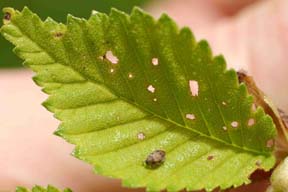Pest Watch | |
|---|---|
| May 6, 2008 | |
|
European pine sawfly has hatched throughout the state. The young larvae are blackish green, developing lighter green bodies later, which allows the dark green stripes and black heads to be more obvious. They will be present in groups on Scots, mugo, and other pines. They feed on the second- and third-year needles, which is all that is present at this time. They do not feed on the expanding candles later in the spring, probably because they are finishing their feeding and dropping to the ground to pupate then. Remember that these are not caterpillars (moth larvae) but are the larvae of wasplike insects. Thus, they are not controlled by Bacillus thuringiensis kurstaki. They are easily controlled with sprays of carbaryl (Sevin), acephate (Orthene), and pyrethroid insecticides. Because they feed in groups, hand removal is also effective. Elm flea weevil adults have emerged and are feeding on Siberian elm and other European elm species.  Elm flea weevil adult and damage.These tiny, reddish beetles eat tiny holes in the foliage, mainly in northern Illinois. They insert eggs into the foliage, with the resulting larvae mining through the leaves, particularly near the tips, later in the spring. Typically, damage is not noticeable from a distance, so treatment may be needed only on smaller trees near doorways, patios, and sidewalks. Acephate (Orthene), bifenthrin (Onyx), carbaryl (Sevin), or imidacloprid (Merit) should provide control. Acephate and imidacloprid, being systemic insecticides, also control leafmining larvae. Insecticide application can also be made in late June to control the second generation of adults. (Phil Nixon and Morton Arboretum) | |
| Author: | Morton Arboretum Phil Nixon |
